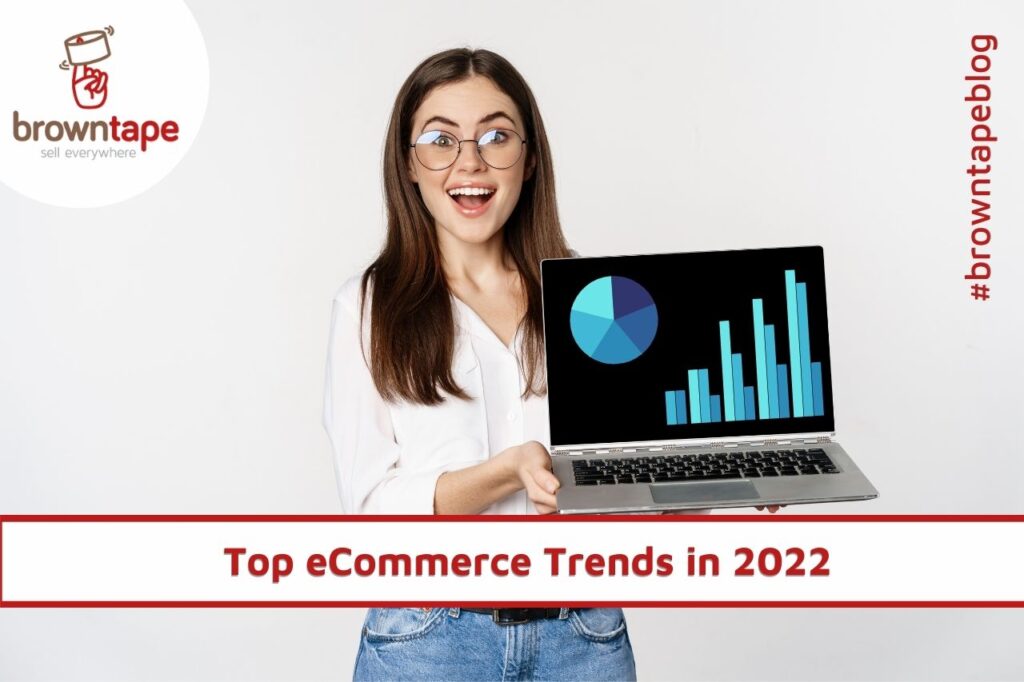Top 5 eCommerce Trends in 2022

eCommerce trends in 2022 that are becoming the game changers for the industry.
Just a decade back, shopping was a great outdoor experience. Stepping out to either buy groceries or clothing or going miles away to specific locations for shopping for a wedding. It was a soulful experience but sometimes tiring too.
E-shopping avenues opened up opportunities to purchase anything and everything from the comforts of your homes. So many factors at various economic levels came into play, into making the eCommerce sector a multi trillion-dollar market. The last two years of the pandemic has given a new definition to e-shopping. The industry has witnessed an up-graph of 77% between 2020 and 2021. This growth has come from not just metros, but also from tier II and III cities as per report by Bobble AI. Top eCommerce trends in 2022 will redefine and transcend the industry to another level.
Online purchases have expanded to groceries, perfumes, and even jewellery which initially hovered over electricals, devices, and clothing. Apart from the key player brands like Amazon, Flipkart, Myntra; new brands like Nykaa, Meesho, and Shopify gained tremendous momentum.
Top eCommerce Trends in 2022, That are the Game Changers
The fact that the physical stores will never completely disappear, consumers would want options and convenience when it comes to shopping. The legacy of “Customer is King” remains undeterred and, the brands must work towards satisfying the customer needs. Consumer behaviour is constantly evolving, henceforth the businesses need to be up to speed with the latest eCommerce trends in 2022. On-ground product launches aren’t just the big thing. Online product showcases and launches have become as bigger, if not less, as the physical events.
Here we discuss some of the top eCommerce trends in 2022 that are turning tables for the sector this year.
Tier 4 Cities, Towns And Villages Will See a Boost
Growth in Social Commerce

Artificial Intelligence (AI) or Augmented reality (AR) commerce on the Rise
Livestream Shopping Will Become More Prominent

Involving social influencers or celebrities giving live product demo, consumers participate and ask questions/comments before taking the buying decision. The experience is somewhat similar to how one would shop in a store with store associates answering your questions. The main difference lies in the ease of shopping within the comforts of your home.
Predominantly invaded by fashion, beauty and personal care brands, India’s Instagram Reels is taking the lead for livestream commerce. After the the ban on Tiktok, Instagram became the showcase or showstopper for many brands.
Livestream eCommerce market is seeing an exponential growth $4-$5 billion by 2025. Beauty and personal care market is topping the charts with above $1 billion GMV. Fashion brands will contribute about 60-70% of the GMV, while beauty and personal care will contribute rest of 30-40%. (according to report by market research firm RedSeer).
Conversational Commerce Bound to be in the ForeFront
Using chat or messaging platforms to influence buyers to purchase your product is another form of online shopping. Through an avid conversation with a brand on Facebook Messenger or WhatsApp, consumers can freely interact directly with the brands. This process of buying becomes a lot more personalized and interactive on a one-on-one basis. Alexa, Siri, Echo, and Google Home are the finest example of voice-enabled shopping apps.
Gartner predicts that 47% of organizations will use chatbots for customer care and 40% will deploy virtual assistants in 2022. Importantly, the overall market size for chatbots worldwide is likely to be over $1.3 billion by 2024.
By putting the customer and business in direct contact through a variety of platforms, conversational commerce enables businesses to better connect with their customers at every step of the purchasing journey.
Conclusion
So, the truth of the matter is – while most industries had struggled to thrive during the pandemic, eCommerce flourished and enjoyed exponential growth. The truth is also to accept, adapt and include the new trends in your business strategy.
There are several eCommerce trends in 2022 to keep an eye on. These trends, infused with new technology developed, ensure smoother customer buying journeys and a better brand experience.
Consumers will continue to evolve and so will their expectations. A seamless, convenient, and memorable shopping experience, is the way to capture their attention. Henceforth, to change the game plan for the year 2022, businesses should invest in the right eCommerce trends in 2022 to keep up with the fast-changing needs and preferences of the consumer.
